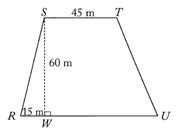JJMforthegold wrote:
Quadrilateral RSTU shown above is a site plan for a parking lot in which side RU is parallel to side ST and RU is longer than ST. What is the area of the parking lot?
1) RU = 80 meters
2) TU = 20(root10) meters
d
Experts-
I can see the hidden right triangle in the picture, but how much of the calculation do I really need to complete to know when each statement is sufficient?
This is a DS question. In most DS questions, you need not do the complete calculation to decide whether the statement (s) is sufficient to answer the question.
In this question also, you need not do the calculation. A mere analysis would suffice.
We have to find out the area of RSTU.
Since ST and RU are parallel to each other, the area of trapezium would be:
(Sum of parallel sides)*(Height of the trapezium)/2
Area of RSTU = (ST + RU)*SW/2 = 30(45 + RU)
Question rephrased: What is the length of RU?
Statement 1: RU = 80 meters
We have the value of RU. Sufficient.
No need to calculate the area.
Statement 2: TU = 20√10 meters.
Let's draw a perpendicular from T on RU. Say it meets RU at U'. Thus, triangle TU'U is a rightangled triangle, where TU' = SW = 60.
So, in for rightangled triangle TU'U, we have hypotenuse TU = 20√10, TU' = 60.
By applying Pythagoras theorem, we can get the value of U'U.
UU'^2 = TU^2 - TU'^2 = (20√10)^2 - 60^2 = A unique value (let's not calculate).
We still did not get the value of RU.
RU = RW + WU' + U'U = 15 + ST + A unique value = 15 + 60 + A unique value = A unique value
Thus, we have RU. Sufficient.
The correct answer:
D
Hope this helps!
Download free ebook:
Manhattan Review GMAT Quantitative Question Bank Guide
-Jay
__________________________________
Manhattan Review GMAT Prep
Locations:
New York |
Bangkok |
Abu Dhabi |
Rome | and many more...
Schedule your free consultation with an experienced GMAT Prep Advisor!
Click here.



















